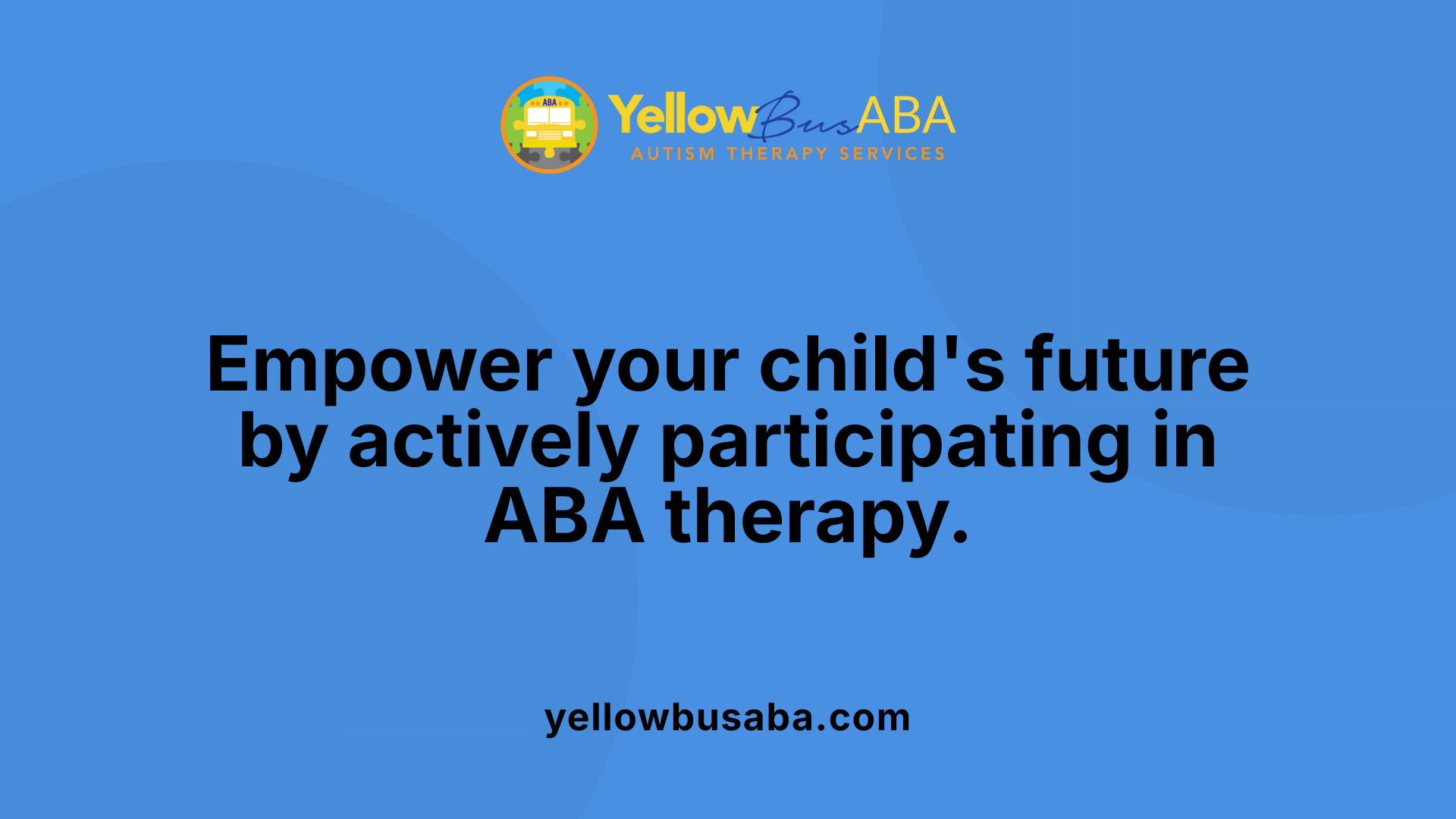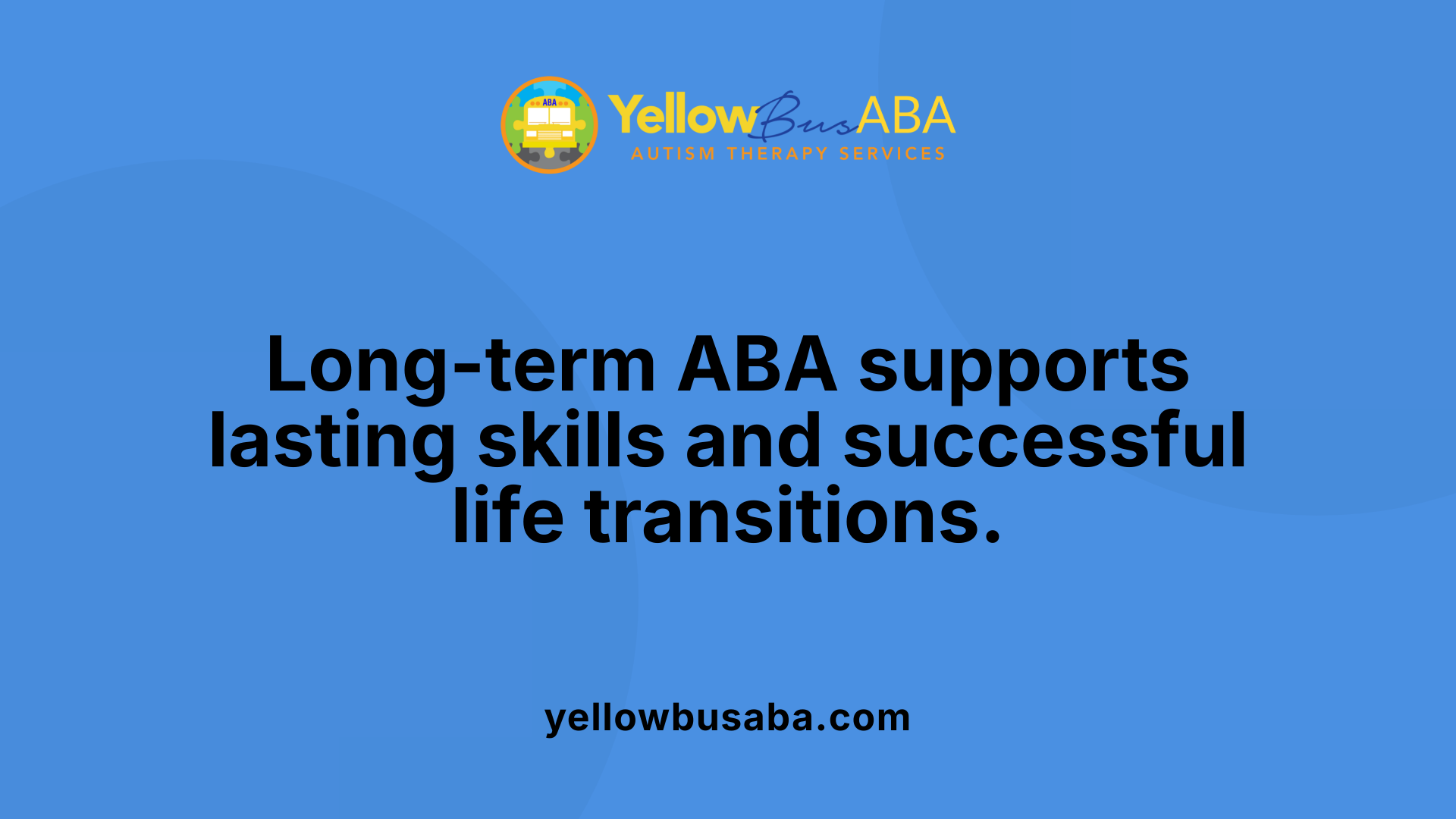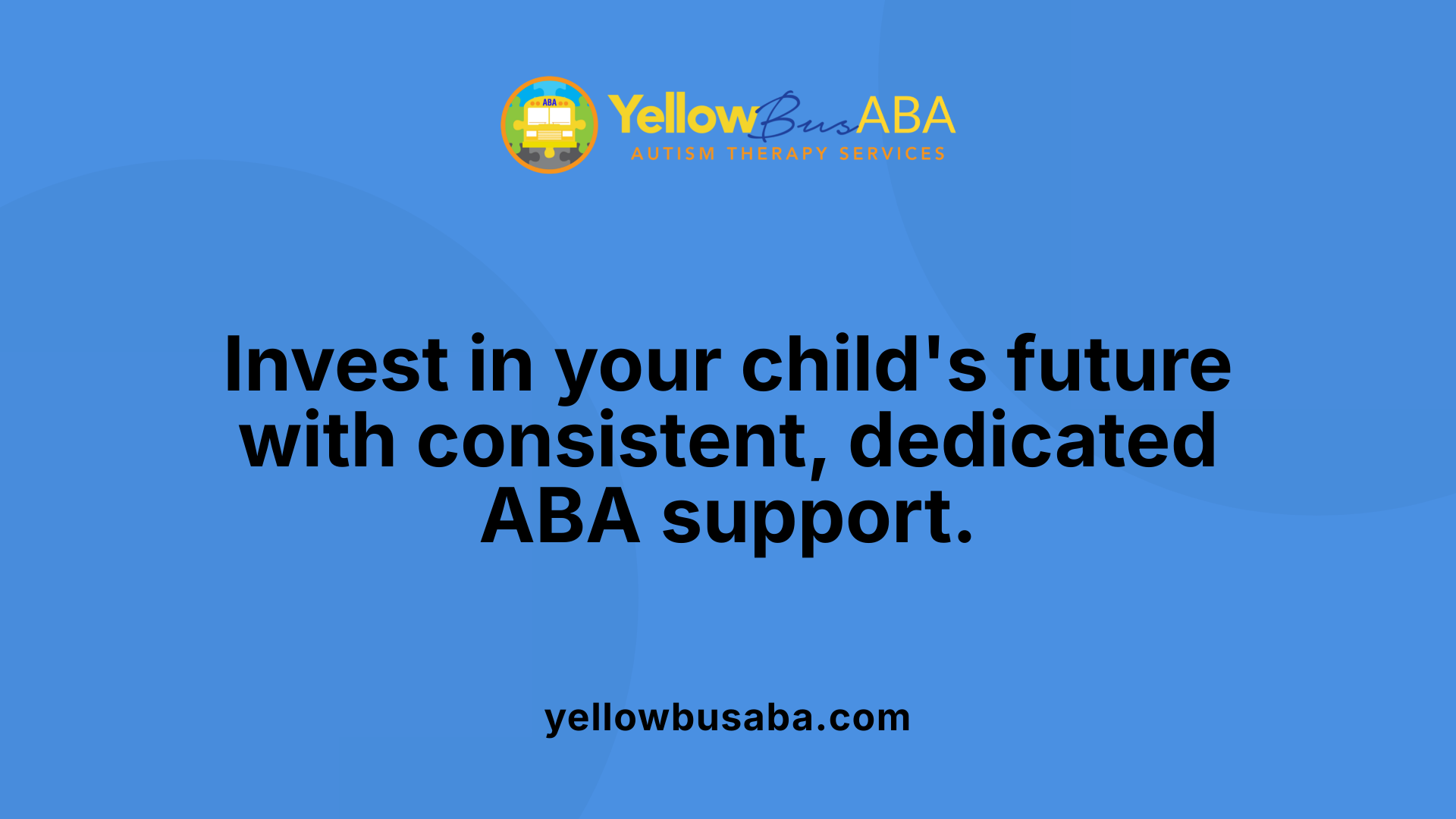The Essential Nature of Long-Term Investment in ABA Therapy
Applied Behavior Analysis (ABA) therapy is widely recognized as a highly effective intervention for individuals with autism spectrum disorder (ASD). However, its success hinges on a critical element: long-term commitment. This article explores why ABA therapy requires a sustained effort over years, how the duration impacts outcomes, and what families can expect as they embark on this journey toward lasting change.
The Typical Duration and Intensity of ABA Therapy

What is the typical duration of ABA therapy for children?
On average, children engaged in ABA (Applied Behavior Analysis) therapy undergo treatment for approximately three to five years. This timeframe allows for substantial skill development and behavioral improvements. However, the exact duration can vary significantly depending on individual needs, the severity of autism symptoms, and specific treatment goals.
Early intervention, particularly during preschool years, tends to facilitate faster progress, often requiring a more intensive approach initially. As children grow and develop, the focus shifts towards maintenance and generalization of skills, which may extend the overall period of therapy.
How often are therapy sessions scheduled, and how long do they last?
ABA sessions are typically scheduled between two to five times per week. Each session usually lasts from 3 to 7 hours, depending on the child's needs and the intensity of intervention required. Many children receive a standard of about 25 to 40 hours of therapy weekly, as per clinical guidelines, especially during early and intensive phases.
Is early intervention more intensive?
Yes, starting ABA therapy at a younger age generally involves more frequent and longer sessions. The goal during early intervention is to leverage greater brain plasticity to foster foundational skills rapidly. This often translates to more hours per week and a more intensive therapy plan initially, which can lead to faster and more noticeable progress.
How is the therapy duration determined?
The length of ABA therapy is highly individualized. Factors influencing the duration include initial assessments conducted by a Board Certified Behavior Analyst (BCBA), the complexity of behavioral challenges, the child's age, and family preferences.
Regular assessments monitor progress and help adjust the treatment plan accordingly. Some children may gradually decrease therapy hours as they acquire targeted skills and start to generalize them across different environments.
What is the overall therapy process?
ABA therapy typically involves an initial intensive phase focusing on foundational skills, followed by a maintenance phase to reinforce learned behaviors and ensure skill generalization. The therapy continues until the child meets specific goals, demonstrates consistent behavior across settings, and caregiver input confirms readiness.
Why is parental involvement important?
Parents and caregivers are integral to the therapy process. Many programs include training to help reinforce skills at home, which enhances learning and generalization. Parental involvement also ensures that the child's progress is supported beyond formal sessions.
How does the therapy adapt over time?
As children progress, therapy plans are flexible and adapt to their evolving needs. Hours can increase or decrease based on ongoing assessments, with the primary aim of achieving lasting behavioral change.
| Aspect | Typical Range | Additional Notes |
|---|---|---|
| Duration | 3 to 5 years | Varies by child, goal achievement, and progress |
| Weekly sessions | 2 to 5 times | 25–40 hours most common, especially early on |
| Session length | 3 to 7 hours | Adjusted according to child's stamina and attention span |
| Intensive early intervention | Often involves more hours per week | Designed to establish foundational skills quickly |
| Long-term goal | Skill mastery, independence, behavior generalization | Progress monitored regularly, therapy adapted accordingly |
Understanding the typical duration and intensity of ABA therapy helps set realistic expectations. It emphasizes the importance of early, consistent, and personalized intervention to support meaningful and lasting improvements.
Understanding the Goals and Phases of ABA Therapy
What is the difference between long-term and short-term goals in ABA?
In Applied Behavior Analysis (ABA) therapy, goals are structured to promote meaningful and lasting improvements in a child's development. These goals are generally categorized into long-term and short-term objectives, each playing a vital role in guiding treatment.
Long-term goals represent the overarching aspirations of therapy. They focus on broad outcomes such as increasing independence, enhancing communication abilities, improving social interactions, and reducing problematic behaviors. Attaining these goals typically requires sustained effort over months or years, depending on the child's initial skills and challenges. They serve as the vision for the child's growth, encompassing their overall well-being and ability to function effectively in various environments.
Short-term goals function as actionable steps toward achieving these broader outcomes. They are specific, measurable objectives that focus on skill acquisition or behavior modification within a shorter time frame—often weeks to a few months. These goals are carefully crafted to target particular behaviors or abilities, such as learning to greet others, using a picture exchange system, or improving self-care routines. They serve as milestones that reflect progress and allow therapists and families to monitor advancement regularly.
Short-term goals are developed based on comprehensive assessments conducted by trained professionals like Board Certified Behavior Analysts (BCBAs). These goals often incorporate techniques such as prompting, shaping, and positive reinforcement to facilitate learning. Data collection is essential; therapists track progress meticulously, analyze patterns, and use this information to update and adapt the treatment plan.
Both types of goals are interconnected and crucial for effective therapy. Short-term goals provide the focus and structure necessary for students to experience success and build confidence. As these objectives are met, progress toward long-term goals becomes more attainable.
The collaborative process involves families, therapists, and the child, ensuring that goals are relevant and motivating. Regular evaluations and progress checks allow for adjustments, ensuring that therapy remains aligned with the child's evolving needs.
Ultimately, understanding and differentiating these goals help create a comprehensive treatment plan that promotes steady, measurable progress and lasting change.
How does the goal setting influence therapy planning?
Goal setting influences every stage of ABA therapy, from initial assessment to ongoing adjustments. Clear, well-defined objectives enable therapists to choose appropriate strategies and determine session structure. For instance, a child working toward increased functional communication may focus on picture exchange or spoken language prompts.
Goals also provide motivation for families and the child, as they offer tangible markers of success. As targets are achieved, confidence and enthusiasm grow, fostering continued engagement in therapy.
Goals are revisited regularly based on assessment outcomes, ensuring that therapy adapts to the child's growth. This dynamic approach facilitates continuous progress and avoids plateauing or stagnation.
By setting both long-term aspirations and short-term targets, ABA therapy remains focused, goal-oriented, and responsive to the child's individual journey.
How long does ABA therapy take to achieve goals?
The time required to reach therapy goals varies widely among children. Several factors influence this duration, including the child's initial skill level, the severity of autism symptoms, the complexity of behaviors targeted, and family involvement.
In general, early intervention tends to yield faster progress because younger children often have higher brain plasticity. Most children participate in ABA therapy for an average of 3 to 5 years, although some may need longer. Longer durations are common for children with more severe symptoms or complex behavioral challenges.
The intensity of therapy also impacts progress. Most children receive around 25 to 40 hours of therapy per week, especially during the intensive phase aimed at foundational skill development. As skills become more stable, therapy hours may decrease while focusing on maintenance and generalization.
Regular assessments—conducted by BCBAs—are essential to monitor progress and adjust the treatment plan. This ongoing evaluation helps to identify when children have mastered specific goals and are ready to move to subsequent objectives.
While progress can sometimes be slow and incremental, patience and consistent implementation are crucial. The primary aim is lasting change rather than quick fixes, emphasizing skill generalization across settings and situations.
What factors influence the length and intensity of ABA therapy?
Several factors determine how long and how intensely a child participates in ABA therapy:
- Initial assessment: A comprehensive evaluation guides personalized treatment planning, affecting the scope and focus of therapy.
- Behavioral complexity: More complex or severe behaviors may require longer and more intensive interventions.
- Age: Younger children often respond more quickly due to neural plasticity, though all ages can benefit from therapy.
- Insurance coverage: The level of insurance approval can influence the duration, frequency, and setting of therapy sessions.
- Family involvement: Active participation by parents and caregivers enhances skill generalization and may influence therapy length.
- Progress rate: Children who make rapid gains might transition to maintenance sooner, while slower progress can extend therapy duration.
The therapy is flexible, allowing adjustments based on ongoing assessments. Therapists may increase or decrease hours or change strategies to optimize progress.
How do professionals determine when to end ABA therapy?
Transitioning out of ABA therapy depends on individual progress toward goals. When a child consistently demonstrates mastery of skills, exhibits behavior in various settings, and functions more independently, therapists collaborate with families to decide if therapy can be phased out.
The process involves observing whether behaviors are maintained over time, across environments, and with minimal support. Follow-up assessments help confirm readiness for transition.
Many children continue to benefit from periodic check-ins or booster sessions to reinforce skills. The decision to conclude therapy is made carefully, ensuring that the child is equipped for ongoing independence.
Understanding these aspects ensures that ABA therapy is tailored to promote the best possible developmental trajectory for each child, emphasizing flexibility, assessment, and collaboration.
The Science and Personalization of ABA
How does ABA use data-driven approaches and develop individualized treatment plans?
ABA therapy is grounded in scientific research that emphasizes a systematic, data-driven approach. Therapists frequently collect and analyze detailed data during sessions to monitor behaviors, measure progress, and make informed adjustments. This continuous assessment ensures that each child's treatment plan evolves based on their unique responses and developmental progress.
Each child receiving ABA therapy has an individualized treatment plan tailored to their needs. These plans are developed after comprehensive assessments by trained professionals such as Board Certified Behavior Analysts (BCBAs). These experts evaluate the child's current skills, behavioral challenges, and potential to create a focused, effective intervention strategy.
The personalized nature of ABA allows therapists to target specific goals, whether improving communication, social skills, or self-care routines. This customization supports more meaningful and efficient progress, increasing the likelihood of lasting positive outcomes.
Why are assessments by trained professionals like BCBAs crucial?
The initial assessment conducted by a BCBA is vital to determine the child's specific needs and to develop a scientifically informed treatment plan. BCBAs use their expertise to observe behaviors, evaluate skill levels, and identify areas that require support.
Ongoing assessments are also essential for tracking progress. They help therapists decide whether to ramp up or adjust interventions, ensuring the therapy remains relevant and effective. Their specialized training ensures that interventions are based on evidence and tailored precisely to each individual.
How does modern ABA therapy incorporate naturalistic and play-based methods?
Today’s ABA practices have moved away from rigid, repetitive drills towards more engaging, natural contexts. Therapists often embed learning into play and everyday routines, making therapy sessions more relevant and less stressful for children.
Naturalistic teaching involves interactions in real-world environments, such as home or community settings. Using play-based methods, children learn social, communication, and self-care skills through enjoyable activities, which promotes better generalization across different settings.
This approach encourages children to develop skills in a way that feels natural, helping them apply what they learn to real-life situations. Positive reinforcement remains a core principle, motivating children to participate and succeed.
Overview of the ABA therapy process
| Aspect | Details | Additional Information |
|---|---|---|
| Duration | Typically 3 to 5 years | Varies based on individual needs, with ongoing assessments |
| Session Frequency | 2 to 5 times per week | Usually 3 to 7 hours per session; most receive 25-40 hours weekly |
| Flexibility | Highly personalized | Hours can increase or decrease based on goals and progress |
| Settings | Home, school, community | To maximize relevance and generalization |
| Goals | Communication, social skills, self-care, problem-solving | Designed for lasting independence and enhanced quality of life |
| Long-term Outlook | Yes, often several years | Focus on sustaining improvements and supporting transition to independence |
Why is this personalized approach effective?
The tailored treatment plans, continuous data collection, and naturalistic methods contribute to the overall effectiveness of ABA. It addresses the specific developmental needs of each child, fostering growth in crucial skills. Parental involvement is also emphasized to reinforce learning at home.
Regular progress checks help refine goals and adapt therapies, ensuring that every child's journey is unique but supported by a strong scientific framework.
What factors influence how long a child undergoes ABA?
Several elements affect the duration of therapy:
- The severity of autism symptoms
- Child’s age at intervention start
- The complexity of behavioral challenges
- Family goals and input
- Insurance coverage
Children with more severe symptoms or those who start therapy early tend to require longer periods of support.
Final insights
Most ABA programs are long-term, emphasizing sustained improvement. The initial intense phase aims to build foundational skills, while subsequent maintenance phases help generalize and retain these skills across environments. The goal is to foster independence and improve overall quality of life.
In summary, ABA therapy’s strength lies in its scientific foundation and its capacity to adapt to each child’s evolving needs. This approach not only promotes skill development but also empowers children and their families to lead fulfilling, engaged lives.
Factors Influencing the Duration of ABA Therapy
What factors influence how long ABA therapy lasts?
The length of ABA therapy for a child can vary greatly, depending on several important factors that are assessed during the early stages of treatment. Since ABA therapy is personalized, its duration is tailored to meet each child's unique developmental needs and goals.
One of the most critical factors is the initial assessment, conducted by a Board Certified Behavior Analyst (BCBA). This thorough evaluation helps determine the child's current skills, behavioral challenges, and needs. Based on this, a customized treatment plan is developed, setting realistic goals and estimating necessary intervention hours.
The severity of symptoms and complexity of behaviors the child presents with also significantly influence how long therapy lasts. Children with more severe autism symptoms, or those exhibiting complex, challenging behaviors, typically require longer and more intensive intervention. These children may need extensive support to develop foundational skills such as communication, social skills, and self-care.
Another crucial aspect is the child's age at which therapy begins. Early intervention, especially during preschool years or even earlier, tends to lead to quicker progress and may allow for a shorter overall duration of intensive therapy. Younger children have greater brain plasticity, making them more receptive to learning new skills, which can accelerate their developmental trajectory.
Finally, access to and coverage of insurance resources can impact the duration of treatment. Many families rely on health insurance plans that may cover specific hours of therapy weekly. Variability in coverage can mean differences in how many hours and how long therapy can be sustained. While some children might have comprehensive coverage enabling longer interventions, others might face limitations that restrict time frames.
In summary, the duration of ABA therapy is highly individualized, shaped by a combination of medical assessments, symptom severity, age at intervention, and insurance resources. This tailored approach ensures that each child receives the most appropriate level of support to achieve meaningful, lasting progress.
Monitoring Progress and Adjusting Therapy
Why is ongoing assessment necessary in ABA?
Regular assessments and progress checks are vital components of ABA therapy. They help ensure that the intervention remains effective and tailored to the child's changing needs. Data collection is at the core of these assessments, allowing therapists to track behaviors, monitor progress toward specific goals, and identify areas needing further attention.
Through consistent evaluation, therapists can determine whether the current approach is successful or if modifications are needed. If a child demonstrates mastery of certain skills, therapy can shift focus to more advanced objectives. Conversely, if challenges persist, the plan might involve increasing hours or refining techniques.
This continuous cycle of assessment and adjustment is fundamental for promoting meaningful development. It allows therapy to evolve in response to the child's growth, making transitions from early intensive phases to maintenance stages smoother and more effective. Ultimately, ongoing assessment ensures that each child's therapy journey is personalized, dynamic, and capable of leading to lasting independence.
The Role of Parents and Environment in Long-Term Success

What is the importance of family involvement in ABA?
Active participation of parents and caregivers plays a vital role in the success of ABA therapy. When families are involved, they help reinforce the skills that children learn during therapy sessions, ensuring these behaviors are practiced consistently in daily life. This reinforcement is essential for skills to become ingrained and for behaviors to generalize across different environments.
Parents trained in ABA strategies can provide immediate positive feedback and rewards, encouraging children to repeat desired behaviors. Their involvement not only supports skill acquisition but also accelerates overall progress by creating a stable, predictable learning environment.
Involvement of families fosters a collaborative approach, enhancing the therapy's effectiveness and helping children transition smoothly beyond structured sessions. When families actively participate, they become advocates and facilitators of their child's development, ultimately leading to more lasting improvements.
How can reinforcement of skills at home and in community settings influence outcomes?
Reinforcing skills outside of therapy sessions is crucial for sustained progress. Parents and caregivers are encouraged to incorporate learned behaviors into everyday routines, such as mealtimes, play, and social interactions.
Community settings, including schools and recreational activities, also serve as important environments for practicing new skills. Consistent reinforcement across various settings fosters independence and helps children become more adaptable.
Effective reinforcement strategies involve offering praise, tangible rewards, or preferred activities contingent on the child's demonstration of targeted skills. This method motivates ongoing effort and reinforces the connection between behaviors and positive outcomes.
How does behavior generalization across environments impact overall progress?
Behavior generalization refers to a child's ability to apply learned skills in different settings and with various people. It's a critical component of ABA therapy, ensuring that progress isn't limited to therapy environments.
Generalization is facilitated by practicing skills in multiple contexts and with different individuals, including family, teachers, and peers. Therapists often incorporate natural interactions and real-world situations into treatment to promote this.
Achieving effective generalization results in greater independence and improved social and adaptive functioning. It ensures that children can navigate everyday situations successfully, making the skills learned practical and meaningful.
| Aspect | Focus | Description |
|---|---|---|
| Parental Role | Involvement and Training | Families are trained to reinforce learned behaviors, ensuring consistency and promoting generalization across settings |
| Reinforcement | At Home and Community | Using praise and rewards to motivate and increase desired behaviors across various environments |
| Generalization | Across Settings | Practicing skills in different real-world contexts to enable children to use skills independently |
Achieving long-term success in ABA therapy relies heavily on these interconnected elements, emphasizing the importance of a supportive, consistent, and integrated environment.
Benefits of Long-Term ABA and Transition Planning

What are the benefits of sustained ABA therapy?
Many ABA therapy programs are designed as long-term initiatives, often spanning several years. This extended duration allows children to develop a comprehensive and stable skill set that can be maintained over time. Consistent therapy ensures that behaviors learned are reinforced regularly, which is vital for their consolidation.
Long-term ABA also aids in the generalization of skills, meaning children can apply what they learn across different settings, such as home, school, and community environments. This versatility is essential for fostering independence.
Progress achieved through sustained therapy can be reinforced and maintained, minimizing regression. As children grow, ongoing therapy can be adapted to meet evolving needs, ensuring continuous development.
A crucial aspect of prolonged ABA intervention is transition planning. This involves preparing children to apply their skills successfully in everyday situations. The goal is to reduce reliance on structured therapy sessions and promote functional independence.
How does transition planning support independence and quality of life?
Transition planning is an integral component of long-term ABA therapy. It focuses on helping children carry over skills learned during therapy into natural life contexts. By establishing real-world relevance, the planning supports sustained independence.
Effective transition strategies include teaching adaptive skills such as self-care, communication, social interaction, and problem-solving. These skills enhance daily functioning and improve overall quality of life.
Children who undergo well-structured transition planning tend to adapt more easily as they age. This planning also considers academic, social, and vocational skills necessary for adult life.
Ultimately, the combination of long-term ABA therapy and thoughtful transition strategies aims to empower children to live more independent, fulfilling lives. Reducing dependency on structured supports, these efforts promote inclusion, self-sufficiency, and well-being.
| Aspect | Focus | Benefits |
|---|---|---|
| Skill Development | Learning broad, foundational skills | Stability, versatility, readiness for new environments |
| Skill Maintenance | Reinforcement over time | Longevity of behaviors, resistance to regression |
| Generalization | Applying skills across settings | Increased independence, less reliance on therapy |
| Transition Planning | Preparing for real-world application | Better adaptation, improved quality of life |
| Family Involvement | Support and reinforcement | Generalization and consistency at home and beyond |
This comprehensive approach ensures that children not only learn necessary skills but also retain and apply them effectively, leading towards a future of greater independence and enhanced life quality.
Conclusion: The Investment in a Child's Future

Why is ABA therapy a long-term commitment for lasting change?
ABA (Applied Behavior Analysis) therapy is recognized as a long-term process because meaningful and sustainable behavioral improvements in children often take time to develop. Most children do not change overnight; rather, they experience slow and steady progress that reflects the complex nature of learning new skills.
The therapy involves continuous, consistent intervention over several years, especially for children with more severe symptoms or those who start therapy at a younger age. Research shows that early intervention can accelerate progress, but ongoing support remains essential to help children generalize and maintain their new skills.
Regular assessments—conducted by trained professionals like Board Certified Behavior Analysts (BCBAs)—help track progress and inform necessary adjustments to the treatment plan. These evaluations are crucial to understanding the child's evolving needs and ensuring that goals remain appropriate.
Family involvement enhances the effectiveness of ABA therapy. Engaging parents and caregivers in training and daily reinforcement helps children integrate skills across different environments, making improvements more lasting.
Long-term commitment in ABA therapy ultimately represents an investment in the child’s future. It aims to foster independence, improve quality of life, and enable children to navigate their social, academic, and personal worlds confidently. Patience and persistence are vital since the journey involves gradual change, but the rewards—lasting behavioral improvements and increased autonomy—are well worth the effort.
Most importantly, maintaining a realistic outlook helps avoid frustration. While some goals are achieved relatively quickly, others require ongoing effort. With continuous evaluation and active family participation, ABA therapy can offer children the best chance to develop essential skills and lead fulfilling lives.
A Lifelong Investment in Independence and Well-Being
The benefits of ABA therapy are maximized when families commit to a long-term, consistent approach. While the journey may extend over several years, each step builds toward independence, social integration, and a higher quality of life. Regular assessment, individualized plans, and active family participation are key to translating therapy efforts into lasting success. With patience, dedication, and ongoing support, ABA therapy can transform the lives of individuals with autism, equipping them with skills necessary for a meaningful and autonomous life.
References
- How Long Does ABA Therapy Last? | ABA for Autism
- 8 Common Myths About ABA Therapy Debunked
- Exploring ABA Therapy Duration & Timeline | Inclusive ABA
- How Long Does ABA Therapy Last? Possible Scenarios
- 10 Things Every Parent Should Know About ABA Therapy
- Establishing a Home-Based ABA Therapy Routine for Early ...
- Who Qualifies for ABA Therapy
- What Is The Treetop ABA Therapy?






